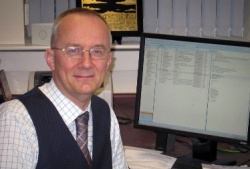The Confocal Laser Endomicroscope
Mark Nicholls reports
A new technique to aid the early detection and diagnosis of inflammatory bowel disease has been developed by UK and Germans researchers. The Confocal Laser Endomicroscope (CLE) contains a powerful microscope that allows clinicians to view bacteria in the intestine that are thought to trigger bowel diseases such as Crohn’s and ulcerative colitis.

Professor Alastair Watson, at the University of East Anglia (UEA), who led the work in partnership with researchers in Mainz, said: ‘Bacteria within the wall of the gut are already believed to play an important role in the development of inflammatory bowel disease and we now have a powerful new tool for viewing this bacteria during routine colonoscopy. This new technique will allow the rapid identification of patients at risk, or in the early stages of this common but distressing group of diseases.’
The causes of Crohn’s disease and ulcerative colitis are still not completely understood but bacteria within the mucous membrane of the gut are thought to play a role. The current method of taking biopsies prevents observation of the bacteria’s exact location and of the way it interacts with the mucous membrane.
The new endomicroscopy technique, which uses a fluorescent dye to highlight the bacteria, allows these exact processes to be viewed at a sub-cellular level during routine colonoscopy.
Collaboration on the new technique has been between the UEA and Johannes Gutenberg University and funded by the Wellcome Trust.
In an earlier study, Professor Ralf Kiesslich, from Mainz, co-ordinated research that found it was possible to find precancerous tissue in patients with inflammatory bowel disease much more easily by using the CLE.
Professor Watson said: ‘We found that bacteria took very well to the fluorescent dye and it became very bright and that the CLE could diagnose and identify infection in the wall of the intestine. We also found that bacteria were much more common in patients with ulcerative colitis and Crohn’s disease.’
The latest study on the technique found that, among the 163 patients, those with Crohn’s disease or ulcerative colitis were far more likely to have bacteria within the wall of their gut than those with healthy intestines. ‘We found the bacteria were patchy,’ Prof. Watson added, ‘but if there are no bacteria we know there is no infection.’
An advantage for patients is that they receive results straight away, rather than having to await the results of a biopsy, or undergo unnecessary biopsy.
However, whilst the advantages from the equipment for clinicians and patients are clear, the researchers acknowledge that there are also drawbacks, notably cost. The CLE can cost between three and four times the price of a standard colonoscope. Professor Watson, who is also a gastroenterologist at the Norfolk and Norwich University Hospital, acknowledged that the machine was still ‘taking its time to find its place’ in clinical practice and that no cost effectiveness studies on it had been published in major journals. ‘This study shows proof of principal. There is no question that it works but is it really worth the money?’ he questioned, adding that there are training costs for endoscopists who are having to become pathologists and recognise what they are seeing with the CLE.
A next step for the researchers, he said, is to identify further applications for the CLE.
26.04.2011











